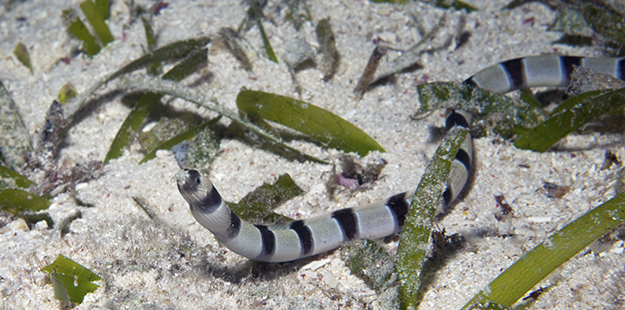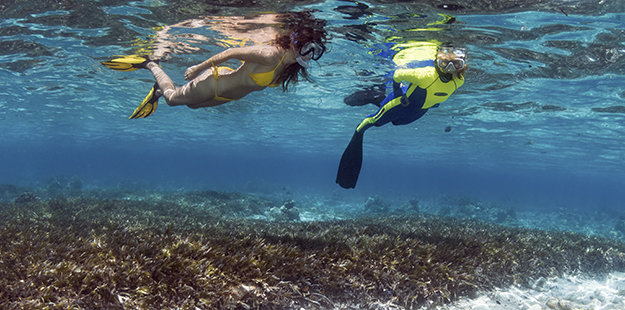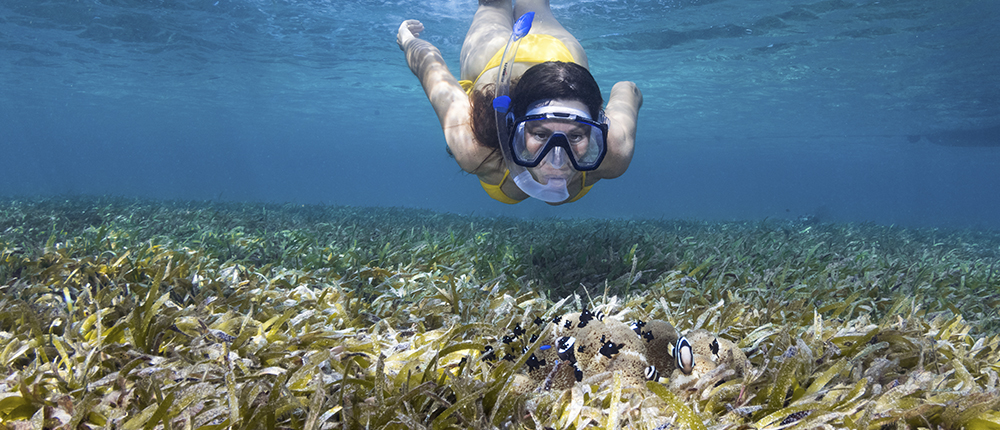A Kick in the Grass

Turtles help to manage seagrass overgrowth, which could block nutrients from reaching the grass roots. Photo by Walt Stearns
Turtles don’t just grab a mouthful of grass, they focus on the younger and more nutritious mid sections of the blades. The older less nutritious portions of the blades are left to float free and drift away, while the close cropping encourages new growth. When turtles graze, they create a marked increase in the productivity and nutrient content of the grass bed. Without turtles, grass beds would suffer. Plants would overgrow and fill the sea floor with decomposing material that block nutrients from reaching roots, and promote the growth of slime molds. The decline in sea grass productivity would in turn have a direct effect on every organism that lives in this shallow ecosystem. Fortunately, there are plenty of hungry turtles in the waters of Wakatobi, and they keep the seagrass meadows well maintained.
A harmless imposter
Snorkelers exploring the shallows may come across what looks like a snake in the grass—and a poisonous one at that. But there’s a pretty good chance that the white-and-black banded creature slithering through Wakatobi’s seagrass beds isn’t the venomous banded sea krait, but instead a harlequin snake eel. Unlike most species of snake eel, which tend to remain buried in the sand and inactive during daylight hours, the harlequin is often out and about when the sun is up. This eel produces no poisons to protect itself, but certainly benefits from its resemblance to the toxic sea krait, a phenomenon that marine biologists refer to as batesian mimicry.

The striking banded creature slithering through the seagrass beds isn’t a venomous sea krait, but instead a harlequin snake eel – enjoy watching him! Photo by Wakatobi Resort.
The harlequin snake eel has a more rounded body and can look like a swimming rope, while eels have a more ribbon-like profile. Once you have identified a harlequin as the harmless imposter it really is, its worth shadowing it for a bit as it slinks through the grass in search of small fish or the occasional invertebrate. Don’t be surprised if the eel seeks shelter, seeing you as a perceived threat, and uses it’s tail to burrow backwards into the sand, which is also an interesting action to witness.

Gliding across the seagrasses at Wakatobi will bring hours of engaging marine life encounters. Photo by Walt Stearns
Those who don mask and snorkel to explore the shallows of Wakatobi Resort can expect a wealth of unexpected and entertaining marine life encounters that don’t occur anywhere else. We invite you to discover all the underwater adventures that await, both by scuba and snorkel.
Is it time to plan your next dive / snorkel trip? Contact our team at office@wakatobi.com
Complete a quick trip inquiry at wakatobi.com
Visit us on Facebook.


